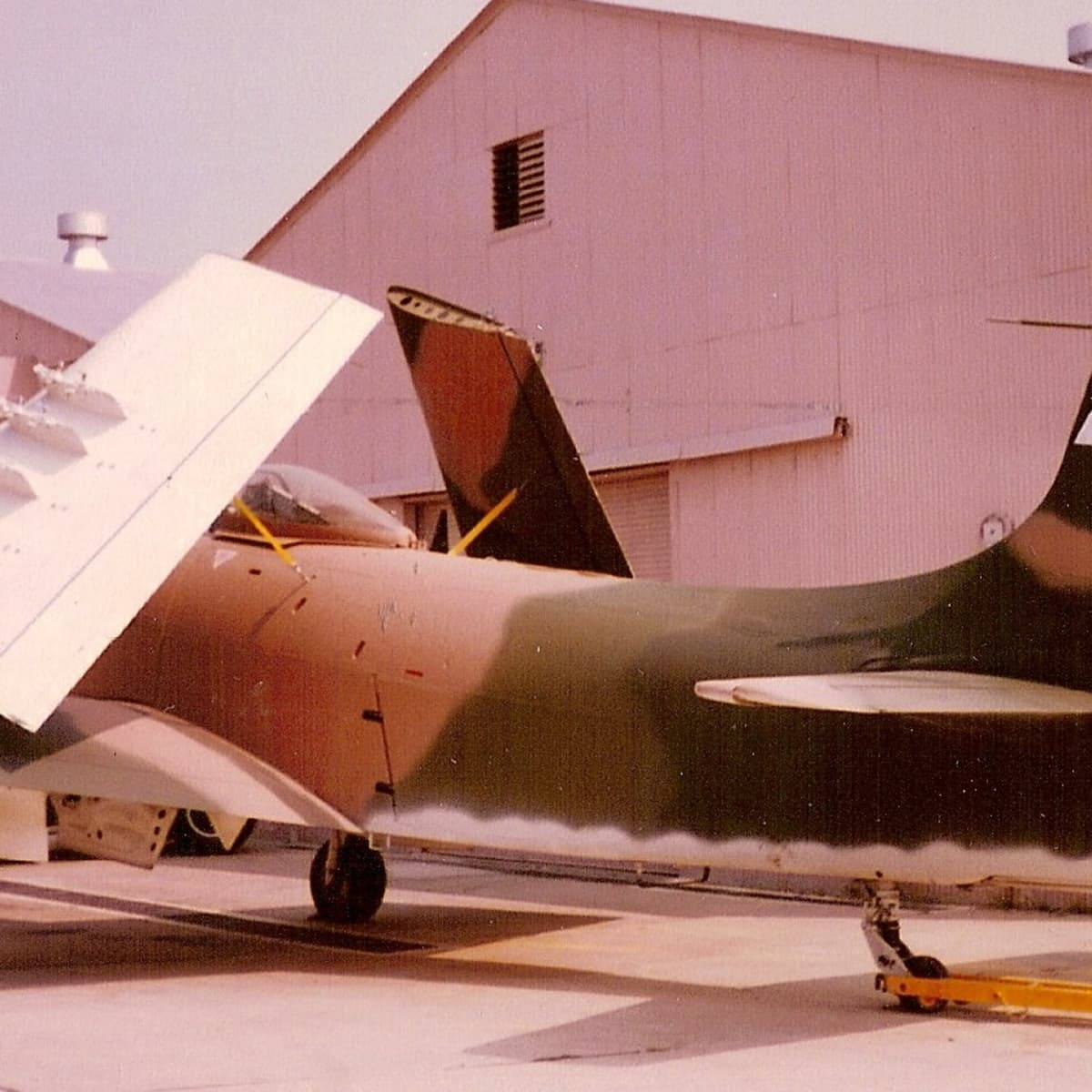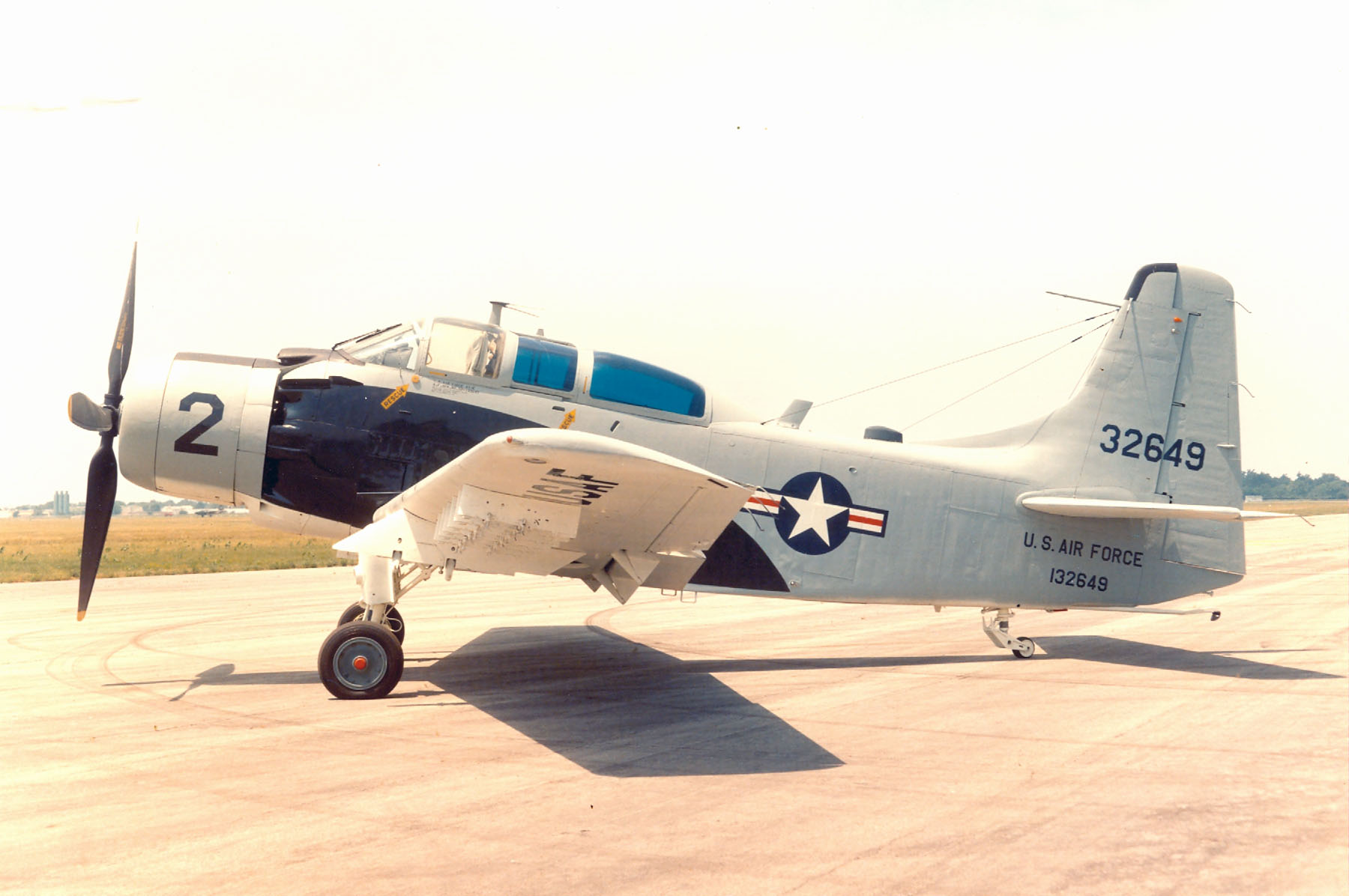A-1 Skyraider Aircraft - Designed during World War II, the Douglas Skyraider proved so useful that it remained in active service until the 1980s, it was designed to combine the roles of dive bombers and torpedo bombers into a single attack aircraft.
It has an impressive payload of 8,000 lbs, significantly more than the Boeing B-17 Flying Fortress's 4,800 lbs payload, and the Skyraider has a 10-hour flight time with an armored undercarriage that protects it from fire.
A-1 Skyraider Aircraft

For enemy fighters in the Korean and Vietnam wars, the sight of a Douglas Skyraider overhead was far more troubling than any of the faster and sleeker fighter jets of the era.
File:douglas Ad 1q Skyraider Vc 35.jpg
A Skyraider could stay for hours, carrying military weapons that it could fire at with devastating accuracy.
The sheer amount of weapons the Skyraider can carry has made it an important part of the US air force for decades.
The Skyraider was introduced too late for use in World War II, but became the backbone of US Navy and Marine strike aircraft during the Korean War.
Interestingly, the only aerial victory attributed to a Skyraider occurred when an AD-4 Skyraider shot down a Soviet Polikarpov Po-2 biplane in 1953.
Postage Stamp 1:110 Mcdonnell Douglas A 1 Skyraider: Papoose Flight, United States Navy
During the Korean War, the Skyraider was flown only by the US Navy and Marines, it was generally painted dark blue and became known only as the "blue plane" to North Korean fighters.
There, the Skyraider's toughness was mainly down to the armor placed on the underside of the aircraft to protect it from ground fire. With a flight time of 10 hours after charging, the Skyraider could stay in specific areas for long periods of time – it also had excellent range for long-range attacks.
After heavy use during the Korean War and the early years of the Vietnam War, the Skyraider would be withdrawn from US military service in 1973.
The armed forces of other nations kept them in service until the mid-1980s, a remarkable testament to the design first proposed by Ed Heinemann 40 years earlier - back in 1944.
Legend Hobby Deluxe 86″ A 1 Skyraider Grey/white Us Navy
This restored AD-4N Skyraider has a mostly original cockpit, with some modifications made for modern safety and flight comfort.
The aircraft you see here is a 1950 AD-4N Skyraider, it has benefited from a full restoration and now shows just 178 flight hours since the work was completed.
This Skyraider is equipped with the original Wright R-3350 26WD engine, otherwise known as the Wright R-3350 Duplex-Cyclone engine. It is a two-row supercharged radial engine with 18 cylinders, a volume of almost 55 liters and up to 3,700 horsepower depending on the configuration.
The R-3350 in this aircraft was completely rebuilt by Anderson Airmotive when the engine was rebuilt and now shows the same dates as the airframe - 178.
Douglas A 1e Skyraider > National Museum Of The United States Air Force™ > Display
This AD-4N Skyraider is currently being offered for sale by the team at Platinum Fighter Sales, the asking price is $750,000, which is not a lot of money in a high stakes Warbird ownership.
If you want to read more about the plane or buy it, you can click here to view the list.
Ben's articles have been featured on CNN, Popular Mechanics, Smithsonian Magazine, Road & Track Magazine, Pinterest Official Blog, eBay Motors Official Blog, BuzzFeed, Autoweek Magazine, Wired Magazine, Autoblog, Gear Patrol, Jalopnik, The Verge and many more.
Founded by Ben in 2010, over the years the site has grown to become a global leader in the automotive and classic car industry, with more than a million monthly readers from around the world and hundreds of thousands of followers on social media.Douglas A- 1 Skyraider (formerly known as the AD Skyraider) is an American single-seat attack aircraft in service from 1946 to the early 1980s. The Skyraider had an unusually long career and was at the forefront of the jet age (when most piston-engine attack or fighter aircraft were replaced by jets); making it known to some as an "anachronism".
Legend Hobby Deluxe 86″ A 1 Skyraider Arc
It was operated by the United States Navy (USN), the United States Marine Corps (USMC), and the United States Air Force (USAF), serving the British Royal Navy, the French Air Force, the Air Force in Vietnam (RVNAF), and others. It remained in US service until the early 1970s.
The jet-powered A-10 Thunderbolt II is based on the specifications of a modernized Skyraider with a high payload and good endurance.
The piston-powered, propeller-driven Skyraider was designed during World War II to meet the US Navy's requirements for a long-range, high-performance, single-seat carrier-based dive/torpedo bomber to follow earlier aircraft such as the Douglas SBD Dauntless, Curtiss SB2C Helldiver, and Grumman TBF Auger.
Designed by Ed Heinemann of Douglas Aircraft, prototypes were ordered on 6 July 1944 as the XBT2D-1. The XBT2D-1 made its first flight on 18 March 1945, and the USN began evaluating the aircraft at the Naval Air Test Cter (NATC) in April 1945.
Vietnam Veterans Look To The Skies
In December 1946, after the designation was changed to AD-1, the first production aircraft was delivered to the Naval Squadron VA-19A.
The AD-1 was built at Douglas' El Segundo plant in Southern California. In his memoir Lonely Sky, test pilot Bill Bridgeman described the routine but sometimes dangerous job of certifying AD-1 passengers fresh off the assembly line at a rate of two aircraft a day for delivery to the US Navy in 1949 and 1950.
The design of the low-wing monoplane began with the Wright R-3350 Duplex-Cyclone jet engine, which was later improved several times. The aircraft had characteristically large flat wings with seven fixed points each. The Skyraider had excellent low-speed maneuverability and carried a large amount of munitions within a significant combat radius. It had a longer hover time for its size, compared to much heavier subsonic or supersonic jets. The aircraft was optimized for ground attack and was armored against ground fire at key points, unlike faster, bomb-carrying fighters such as the Vought F4U Corsair or the North American P-51 Mustang, which US forces retired by the 1960s.
Shortly after Heinemann began designing the XBT2D-1, a study was published showing that for every 100 lb (45 kg) weight reduction, takeoff was reduced by 8 ft (2.4 m), combat radius increased by 22 mi (35 m). km) and rate of climb increased by 18 ft/min (0.091 m/s). Heinemann immediately had his designers begin a program to find weight savings on the XBT2D-1 design, no matter how small. Simplification of the fuel system resulted in a reduction of 270 lb (120 kg); 200 lb (91 kg) by removing the internal bomb bay and hanging external stores from the wings or fuselage; 70 lb (32 kg) with a diving brake on the hull; and 100 lb (45 kg) with the older rear wheel design. In d, Heinemann and his designers achieved a weight reduction of more than 1,800 lb (820 kg) over the original XBT2D-1 design.
A 1 Skyraider
The Navy AD series was originally painted ANA 623 Brilliant Navy Blue, but in the 1950s, after the Korean War, the color scheme was changed to light gray and white (Fed Std 595 27875). Originally the Navy used a gray and white scheme, in 1967 the USAF began painting its Skyraiders in camouflage with two shades of heather and one tan.
Used by the US Navy over Korea and Vietnam, the A-1 was the primary close-range aircraft for the USAF and RVNAF during the Vietnam War. The A-1 was known for being able to take hits and keep flying thanks to armor around the cockpit to protect the pilot. Beginning in the mid-1960s, it replaced the Grumman A-6 Intruder as the Navy's primary supersonic-based medium attack aircraft. However, the Skyraiders continued to operate from smaller Essex-class aircraft carriers.
The Skyraider consists of seven versions, starting with the AD-1, AD-2 and AD-3 with various minor improvements, up to the AD-4 with the more powerful R-3350-26WA engine. The AD-5 was significantly enlarged, allowing two crews to sit side-by-side (this was not the first multi-crew variant, the AD-1Q was a two-seater and the AD-3N a three-seater); it also came in a four-seat night attack version, the AD-5N. The AD-6 was an improved AD-4B with an improved low-level bombardment, and the final production version of the AD-7 was upgraded to the R-3350-26WB engine.
Which worked similarly to the ejection seat, but with two rockets that ejected the pilot from the cockpit.
Ad And A 1 Skyraider
In addition to serving as an attack aircraft during the Korean and Vietnam eras, the Skyraider was modified to serve as a carrier warning aircraft, replacing the Grumman TBM-3W Avger. It performed this role in the USN and Royal Navy, and was replaced by the Grumman E-1 Tracer and Fairey Gannet, respectively, in that service.
Skyraider production began in 1957 with a total of 3,180 built. In 1962, the current Skyraiders were redesignated from the A-1D to the A-1J and were later used by both the USAF and the Navy during the Vietnam War.
Skyraider was produced too late

A 1 skyraider engine, a 1 skyraider model, skyraider aircraft, a 1 skyraider 1600mm, skyraider aircraft for sale, a-1 skyraider, douglas a-1 skyraider, a 1 skyraider association, skyraider 1, a 1 skyraider for sale, douglas skyraider aircraft, a 1 skyraider cockpit


0 Comments